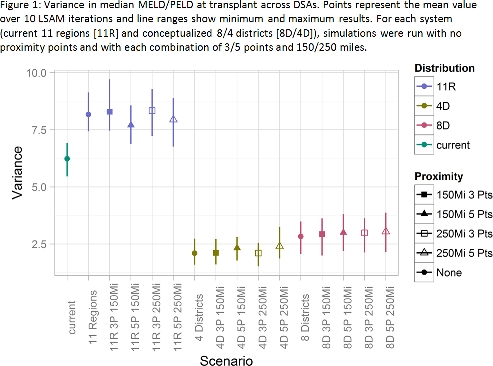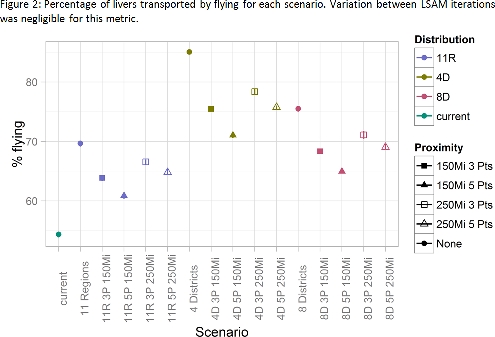Impact of Proximity MELD/PELD Points on Liver Redistricting Scenarios.
1Scientific Registry of Transplant Recipients, Minneapolis
2United States Naval Academy, Annapolis
3Stanford, Palo Alto
4University of Minnesota, Minneapolis
5Surgery, University of California, San Francisco
6Surgery, Yale University, New Haven.
Meeting: 2016 American Transplant Congress
Abstract number: 441
Keywords: Allocation, Liver, Public policy
Session Information
Session Name: Concurrent Session: Liver: MELD, Allocation and Donor Issues (DCD/ECD) 1
Session Type: Concurrent Session
Date: Tuesday, June 14, 2016
Session Time: 2:30pm-4:00pm
 Presentation Time: 2:42pm-2:54pm
Presentation Time: 2:42pm-2:54pm
Location: Room 304
Background: To address geographic disparity in liver allocation, a new organ distribution system consisting of 4 or 8 districts has been proposed (Gentry, Am J Transplant 2013). The OPTN Liver Committee is considering including proximity points for candidates within 150 or 250 miles of the donor.
Purpose: We evaluated the impact of proximity preference on disparity in liver distribution.
Methods: We used the liver simulated allocation model (LSAM) to project disparity (variance in median MELD/PELD at transplant by DSA) and transport burden (percentage of organs transported by flying) with bonus proximity MELD/PELD points.
Results: Broader sharing in the current 11 regions was projected to increase variance in median MELD/PELD at transplant compared with a current policy simulation. The 8- and 4-district maps decreased this variance by half (Figure 1). Adding proximity points did not substantially reduce this disparity benefit, but did reduce the percentage of organs transported by flying; flight percentage was lowest for the 8-district 5-point 150-mile scenario (Figure 2, 65%).


Conclusions: Proximity MELD/PELD points can mitigate the transport burden of liver redistricting while reducing the disparity in median MELD/PELD at transplant.
CITATION INFORMATION: Gentry S, Pyke J, Schladt D, Zeglin J, Kim W, Lake J, Hirose R, Mulligan D, Israni A. Impact of Proximity MELD/PELD Points on Liver Redistricting Scenarios. Am J Transplant. 2016;16 (suppl 3).
To cite this abstract in AMA style:
Gentry S, Pyke J, Schladt D, Zeglin J, Kim W, Lake J, Hirose R, Mulligan D, Israni A. Impact of Proximity MELD/PELD Points on Liver Redistricting Scenarios. [abstract]. Am J Transplant. 2016; 16 (suppl 3). https://atcmeetingabstracts.com/abstract/impact-of-proximity-meldpeld-points-on-liver-redistricting-scenarios/. Accessed December 9, 2025.« Back to 2016 American Transplant Congress
